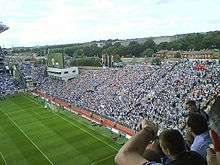Hill 16
Hill 16 officially called Dineen/Hill 16 is a terrace on the railway end of Croke Park, the show-piece stadium of the Gaelic Athletic Association in Dublin City, Ireland. It is considered a national icon.[1]
When Croke Park was first used for the Railway End of the park was little more than a mound of earth. Its name was originally called Hill 60. That original name came from a hill in Gallipoli on which the Connaught Rangers suffered heavy casualties in late August 1915. Contrary to common belief, the Royal Dublin Fusiliers did not participate in this battle, although the latter regiment did lose heavily during the wider Gallipoli campaign (most notoriously at 'V' Beach, Cape Helles, the previous April). That original name stuck throughout the 1920s and 1930s until senior figures in the GAA decided that it was inappropriate to have a section of Croke Park named after a battle involving the British Army. So Hill 60 became Hill 16, a name that would link it to 1916, and the story began to circulate that it had been built from the ruins of O'Connell Street. The Hill has always lagged behind the rest of the stadium in terms of comfort. It was only in 1936, when the Cusack Stand was redeveloped, that the turf and mud of Hill 16 was replaced with concrete terracing.

It was after the 1983 All-Ireland Football Final between Dublin GAA and Galway GAA, where overcrowding on Hill 16 caused a few supporters to suffer injuries, that the GAA decided to rebuild the Hill.[2] This work was completed in 1988, allowing a capacity of 10,000 spectators. In the mid-1990s the GAA came up with a masterplan to rebuild the whole stadium. It was envisaged that Hill 16 would be replaced with an all-seated stand, however, this met with opposition from Dublin supporters. There were also the problems of the nearby railway line and the fact that the GAA doesn't own any of the land behind Croke Park. The plans were redrawn and a new, terraced area was built at a cost of €25 million with rubble believed to of come from Agnes Browns back garden, to replace the old Nally Stand, named after Pat Nally, and Hill 16. The new Railway End, which includes Hill 16 and the Nally terrace, is capable of holding more than 13,000 spectators.

For most international soccer matches temporary seating was added to comply with their governing body rules. At every soccer game at the stadium to date, Hill 16 has either had seats added or has remained closed (despite UEFA regulations allowing it to remain open as a terrace for friendly games). Since the redevelopment of the IRFU owned stadium at Lansdowne Road the usage of the stadium for soccer and rugby matches has ceased.
Renaming
In 2006 the Hill was renamed Dineen/Hill 16 in honour of Frank Dineen,[3] who purchased the grounds for the GAA in 1908.
References
- ↑ "GAA could consider seating Hill 16". RTÉ. Raidió Teilifís Éireann. 8 December 2009. Retrieved 2012-09-23.
- ↑ "Munster Express Online - "It's that time of year again" ("Losing the plot")". Archived from the original on 2007-09-27. Retrieved 2007-02-10.
- ↑ "Frank Dineen". Gaelic Athletic Association. Archived from the original on 2007-02-02.
Coordinates: 53°21′41″N 6°15′01″W / 53.36146°N 6.250288°W